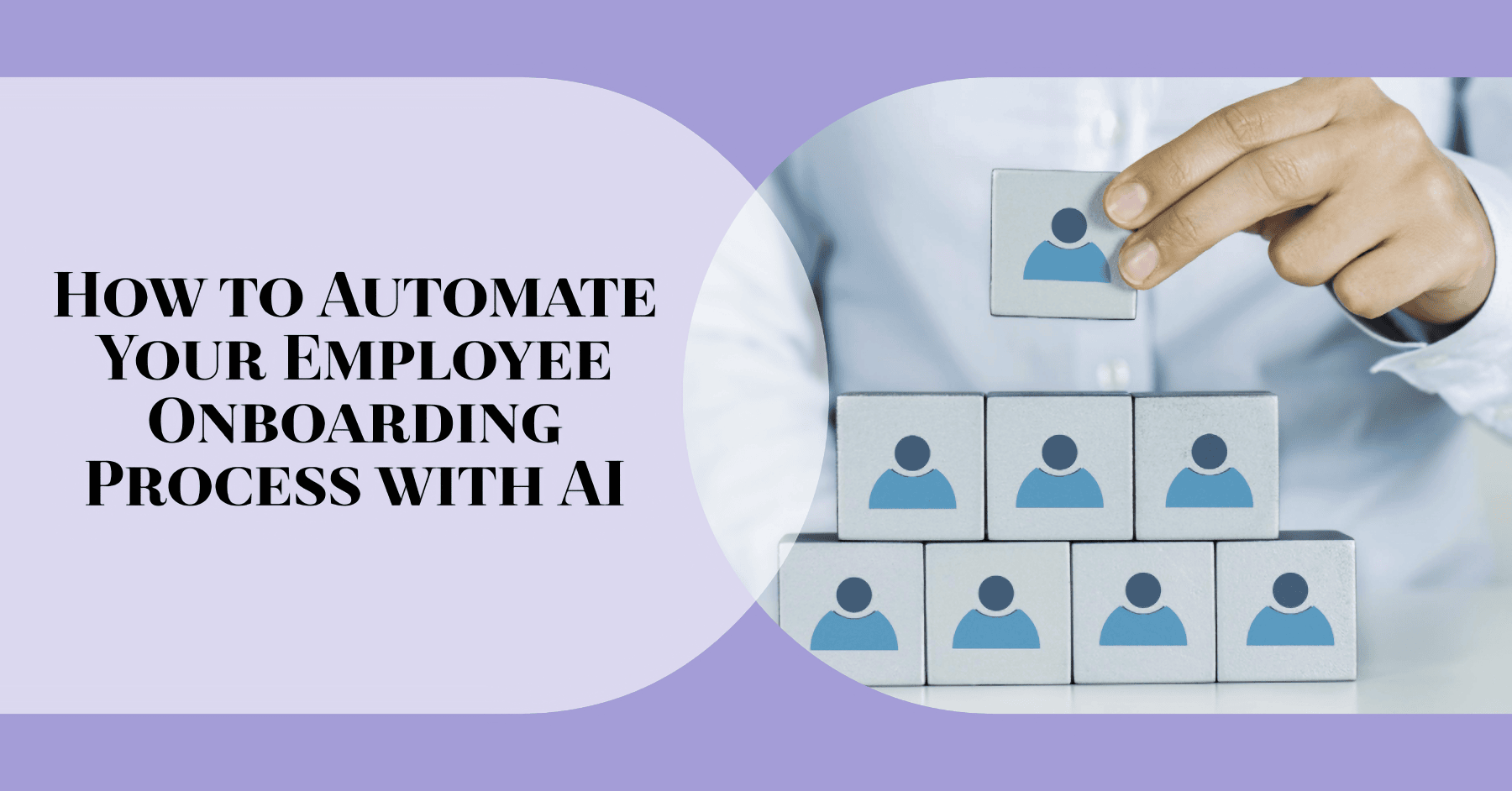Employee onboarding is crucial. Statistics show that only 12% of U.S. employees believe the company they work for has a satisfactory onboarding process. Yet too often, onboarding is treated as an afterthought, leaving new hires feeling disconnected and companies struggling with high attrition rates.
Artificial intelligence (AI) is poised to change that. By automating repetitive administrative tasks, providing personalized recommendations, and gleaning actionable insights from data, AI-powered solutions can enhance onboarding processes like never before.
This article explores how AI is transforming employee onboarding, overviews real-world use cases, provides actionable guidelines for implementation, discusses evaluation metrics, and predicts AI's growing future role in onboarding and beyond. Read on to learn how to harness AI's immense power to revolutionize the employee experience right from day one.
The Rise of AI in Employee Onboarding
AI adoption has accelerated across industries, including human resources. By digitizing and analyzing hiring and employee data, AI systems can generate strategic insights to improve everything from talent acquisition to employee development.
Now, leading-edge companies are applying AI to transform core HR processes like onboarding. AI tools can ingest new hire paperwork, populate HR systems, assign training content, and even match employees with mentors - all while providing managers with an overview of onboarding analytics.
The benefits abound: AI allows HR teams to personalize each new hire's experience, ensure role-specific development, and focus on high-value strategic initiatives rather than administrative minutiae. Most importantly, AI can help unify a fractured onboarding process into a seamless, engaging experience.
AI-Powered Onboarding: Key Use Cases
AI is already powering next-generation employee onboarding at forward-thinking companies. Real-world examples prove that AI can:
Streamline Logistics and Paperwork
HR platform Phenom uses AI chatbots to handle common new hire inquiries, freeing recruiters to focus on culture-building initiatives. Meanwhile, HR technology provider Syndio applies algorithmic decision aids to assess pay equity dynamics between similar employees - identifying unexplained pay disparities based on gender or race and ensuring compensation fairness.
Use Case | Company | Outcome |
|---|---|---|
Chatbots | Phenom | AI-powered chatbots manage 20% of inquiries from candidates and new hires, improving recruiter capacity by over 10 hours per week |
Pay Equity Analysis | Syndio | Algorithmic decision aids assess compensation differences between employees in similar roles, enabling companies to resolve unexplainable pay gaps over 5x faster than manual audits |
Personalize Onboarding Journeys
Enterprise learning platform Allego taps AI to recommend microlearning content to sales representatives during onboarding based on their level, role, and goals. This tailored approach improves capability-building by over 40%.
Similarly, workplace culture platform Culture Amp developed an AI-powered mentoring program. The algorithm matches new hires to mentors based on shared competencies, interests, and work styles.
Use Case | Company | Outcome |
|---|---|---|
Personalized Learning | Allego | AI recommends targeted sales training content for new reps, improving capability-building rates by over 40% |
Mentor Matching | Culture Amp | AI algorithm matches new hires with ideal mentor counterparts, facilitating valuable connections |
Derive Data-Driven Insights
Predictive analytics tools like Visier use machine learning algorithms to uncover correlations between onboarding activities and downstream employee performance. These insights allow organizations to pinpoint the most critical areas for investment.
By coupling such workforce analytics with real-time dashboards, HR leaders can continually refine onboarding processes to drive engagement, productivity, and retention over time.
Use Case | Company | Outcome |
|---|---|---|
Onboarding Analytics | Visier | Advanced analytics uncover links between specific onboarding elements and employee productivity / retention rates, highlighting priority areas for investment |
The possibilities are vast. Whatever the use case, AI-based onboarding solutions share a common thread - harnessing data and intelligence to improve HR processes, employee experiences, and business outcomes.

Integrating AI into Your Onboarding Process
Ready to implement AI-powered onboarding? Follow these best practices:
Evaluate Potential AI Solutions
HR teams have growing options for AI-based onboarding, from chatbots to mentoring algorithms to pulse survey bots. Assess tools against critical criteria:
Integration with your existing HR systems
Customizability to your workflows
Flexibility to meet future needs
Proven ROI case studies
Shortlist vendors that meet requirements. Request demos, perhaps conduct a small pilot test, then make an informed selection.
Get Stakeholder Buy-In
Schedule an executive briefing to demonstrate the AI solution and share projected gains, like improved new hire productivity and retention. Outline any process changes, additional data governance requirements, and plans for measuring ROI. Garnering leadership support early smooths integration.
Clean and Standardize Data
Quality data is essential for AI tools to derive accurate insights over time. Scrub employee datasets, establish data governance protocols, and implement processes that ensure high integrity records moving forward.
Roll Out in Phases
Rather than force-fitting AI across the entire onboarding journey at once, target high-potential use cases first, like new hire paperwork. As the technology interfaces with actual workflows, continually gather user feedback to fine-tune the system until it delivers maximum value. Then expand its application across other aspects of onboarding.

Measuring and Evaluating AI's Impact
The true test of any AI system comes after deployment. HR leaders must continually gauge effectiveness and steer ongoing enhancements - a process called "supervised learning".
Key Evaluation Metrics
Track metrics like:
New Hire Ramp Time: Time for new employees to reach full productivity
Program Satisfaction Scores: Participant feedback on onboarding experience
30/60/90 Retention Rates: Employee turnover numbers at each milestone
Hiring Manager Sentiment: Surveys on manager perceptions of onboarding success
Compare benchmarks before and after AI implementation to quantify gains. Highlight successes to build internal support.
Continuous Improvement
AI-powered onboarding solutions can ingest new data on an ongoing basis to continually refine recommendations and insights over time. As processes evolve or the organization pursues new strategic priorities, the system remains highly adaptable.
Set regular check-ins to validate that the AI tool aligns with current needs. Be ready to provide additional feedback and make tweaks to maximize impact. View it as an ever-enhancing partnership between humans and technology.
The Future of AI in Employee Onboarding
If AI's present applications show such promise, its future potential is exponentially greater. Soon, smart virtual assistants may guide each new hire's personalized journey, while natural language processing chatbots field common questions in a lifelike manner.
Immersive extended reality simulations could enable hands-on practice in high-risk scenarios without real-world consequences. As predictive analytics uncover new correlations between behaviors and performance, real-time nudges will encourage optimal habits from day one.
For HR leaders, that future is nearer than we may think. Already, AI has moved beyond novelty to deliver real returns on investment. The organizations that embrace AI now will have a first-mover advantage as onboarding - and many other HR processes - become increasingly automated and enhanced by intelligent algorithms.
Rather than be wary of AI's rise, welcome the possibilities. Lean into the technology and realize immense gains in productivity, efficiency, and experiential excellence. Help shape AI as a collaborative partner to transform not just human resources, but what it means to be human at work.
AI-powered onboarding solutions offer immense potential to revolutionize the employee experience by streamlining logistics, personalizing content, and providing data-driven insights. Follow best practices around selection, integration, and continuous improvement to implement AI that drives quantifiable improvements. Partner with this burgeoning technology to enhance both processes and people.


